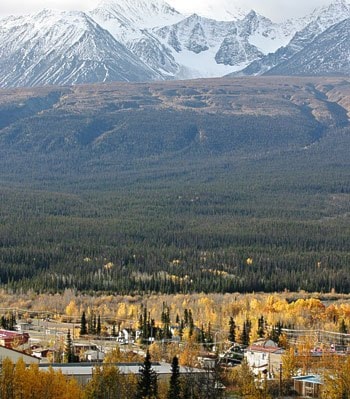Haines Junction is looking to turn its spruce beetle problem into an energy solution.
The village has partnered with Yukon Energy, the Champagne and Aishihik First Nations, the Dakwakada Development Corporation and the Yukon Research Centre’s Cold Climate Innovation Centre to look at the potential for a biomass energy plant.
The plan is to feed the two- to three-megawatt power plant with waste wood from the region.
Thanks to the invasive spruce beetle, there is a lot of dead wood around Haines Junction.
In the forests surrounding the village, there are about 380,000 hectares of beetle-killed wood, with another 100,000 hectares available from the Fox Lake and Minto burns.
Originally, Yukon Energy was looking at putting in a 25- to 30-megawatt plant in the area, but after holding a public meeting last December, the utility decided to scale back those plans, said Janet Patterson, spokesperson from Yukon Energy.
It’s hoped that the bulk of the $850,000 needed to fund the engineering and design study will come from Natural Resources Canada, with the rest coming from the five Yukon partners.
“We can’t do all this on our own,” said Patterson. “We’re faced with a situation where we need to find more power, and our preference is for it to be clean renewable power, so we need to work with others to make that happen.
“In this case we have a number of other groups that are keen, and can all see the benefits of it.”
One of those is the Yukon Research Centre, an arm of Yukon College.
There is much potential to this kind of technology, said Stephen Mooney, director of Cold Climate Innovation at the research centre.
Besides producing electricity, a biomass plant would throw off excess heat. That could be used to heat homes or greenhouses, or even to dry fish or meat.
There might even be potential to turn the plant’s emissions into a usable fuel.
“There is now technology to pull CO2 out of the emissions and turn it into biodiesel by running it through algae,” said Mooney.
While this biomass plant would be a first for the territory, the technology is already used to generate electricity across Scandinavia, said Mooney.
The biggest challenge will be to find an affordable way to get the feedstock to the plant, he said. A big part of the early engineering work will study that problem.
“We’re going to try to make it as comprehensive as possible, looking at the economics, looking at the technology, looking at the policies around that,” said Mooney. “There’s a lot of questions to be answered.”
A tender for the project has already gone out and submissions are being reviewed.
The hope is to have results by early next year, after which the final decision will be made on whether or not to go forward with the project, said Patterson.
“We’ll keep our fingers crossed,” she said.
Contact Josh Kerr at
joshk@yukon-news.com
